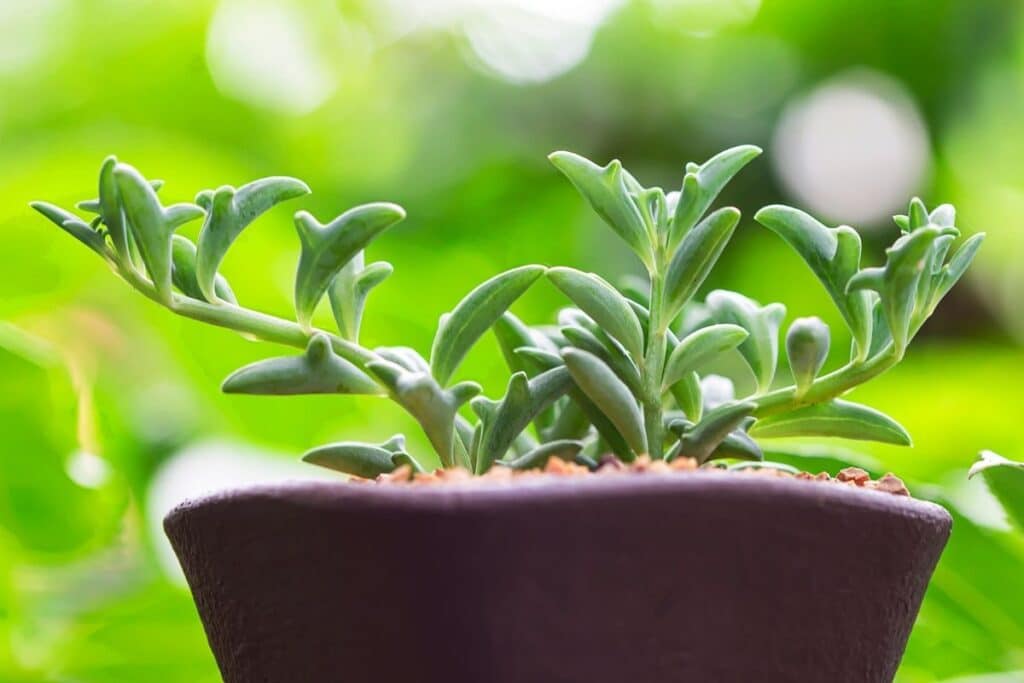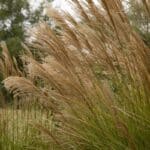Delightful and easy to care for, this rare succulent with leaves that resembles a pod of jumping dolphins is the perfect addition to any cactus or succulent collection. Read further to learn how to care for this adorable succulent.
What is a String of Dolphins?
Curio peregrinus, also known as string of dolphins or dolphin necklace, is a succulent plant from the daisy family (Asteraceae). It is an interesting hybrid of the string of pearls (Curio rowleyanus) and the hotdog cactus (Curio articulatus).
The plant used to belong to the genus Senecio which is why you can find many articles calling the plant Senecio peregrinus or Senecio x peregrinus (1).
There are still unresolved problems with its true classification but regardless of its taxonomic identity, there is no doubt that these plants might just be the most adorable thing you will see.
String of dolphins are the perfect choice for adding texture and color to a cactus and succulent collection. It has a trailing habit with long narrow stems that can reach up to 3 feet long. They can form mats when grown on the ground or cascading curtains when grown as hanging plants.
Along the stems, you can see the main attraction. The reason why these plants have become so popular. Succulent, curvy, green leaves that have an uncanny resemblance to a pod of tiny dolphins grow from the long stems (2). The dolphin-like leaves are attached to the stem by their ‘tail’ which makes them seem to be jumping!
Although they are mainly grown for their very striking foliage, the flowers of these plants are still a feature. From May to June, string-of-dolphin plants become adorned with fragrant, white, pom pom-like flowers with bright red and orange stamens poking at the top.
Some gardeners often cut them off because they can turn into untidy dandelion-like tufts when they dry but the cinnamon-like fragrance and the delicate beauty of these flowers may just be worth the extra clean-up.
Much like their cetacean namesake, the string of dolphins is very rare and can only be found in a few garden centers and online shops.
How to Take Care of String of Dolphins Succulent
Surprisingly, the string of dolphins is pretty low maintenance. Unlike other succulent plants, they are quite forgiving and will thrive beautifully under good conditions.
How much light does String of Dolphins need?
Like most succulents, the string of dolphins does well in partial shade to full sunlight. They have this feature in their leaves called “leaf windows” which are translucent areas on the top side of the leaf. These leaf windows prevent too much damage to the lead due to too much sun.
Despite this, they can still get burned from prolonged exposure, so when growing a string of dolphins outdoors, place them in shaded areas where they can avoid the harsh afternoon sun. On the other hand, when growing indoors, place them near a window, so they can receive plenty of light (3).
How often should you water String of Dolphins?
The watering needs of a string of dolphins will depend on the conditions in your area. These plants will need regular watering during the growing season which is from spring to summer. Water every week, making sure to allow the soil to become dry to the touch before the next watering (4).
What is the optimum temperature for String of Dolphins?
Although it prefers cooler temperatures, the string of dolphins is not very cold. It can only tolerate down to a minimum of 30oF. The plant does not do very well under hot conditions either as too much heat can cause damage to their succulent leaves. For the best growth, keep your string of dolphins under mild to warm temperatures (65 to 85oF) (3).
What is the best growing/potting mix for String of Dolphins?
String of dolphins has the same soil requirements as other succulents. They need well-drained soil that can still hold moisture (5). Plant your string of dolphins in a potting mix made specifically for cacti and succulents or you can make your own soil mix with equal parts sand and regular potting soil.
Does String of Dolphins need fertilizer?
Although the string of dolphins is not a heavy feeder, it will benefit from the occasional feeding, especially during the growing season. There are many fertilizers available for plants but choose the one that has nutritional balance made for cacti and succulents. Feed your plants based on the package instructions.
If no special fertilizer is available, general-purpose fertilizer for houseplants can be used but it has to be diluted to one-quarter the strength (4).
Propagating String of Dolphins
String of dolphins is easily propagated through stem cuttings. To do this, simply choose a stem section with healthy leaves and cut it with a sterilized blade. Place the stem cutting on dry potting soil and allow the cut portion to form a callous.
Once roots have grown from the callous, you can plant your new string of dolphins in its regular succulent potting mix and watch as tiny new dolphins grow and frolic about in your garden.
Up Next: How to grow succulents from cuttings
References
Reference List:
(1) “Curio“. Species 2000 & ITIS Catalogue of Life, 2019 Annual Checklist. Species 2000. 2019.
(2) Baldwin D.L. “Succulents Simplified: Growing, Designing, and Crafting with 100 Easy-Care Varieties“. Timber Press. 2013. P 252.
(3) Afra A. “The Succulent Manual: A guide to care and repair for all climates“. Andrea Afra. 2018.
(4) Cian J. “Stylish Succulent Designs: & Other Botanical Crafts“. Page Street Publishing. 2019.
Close
Image by depositphotos.com/864O-SHI-ADISORN







